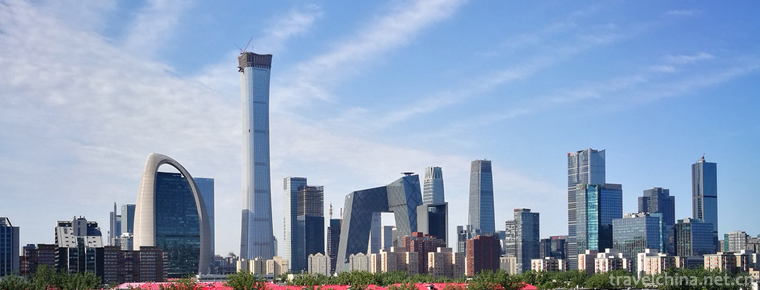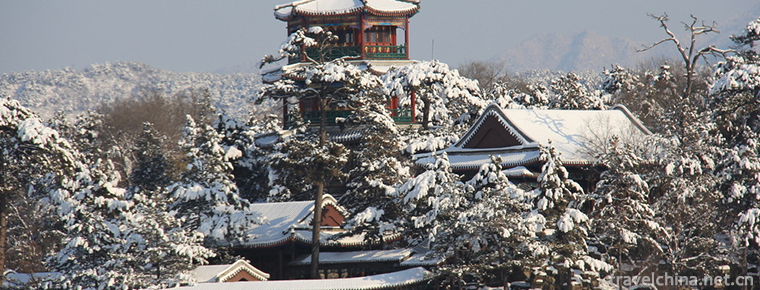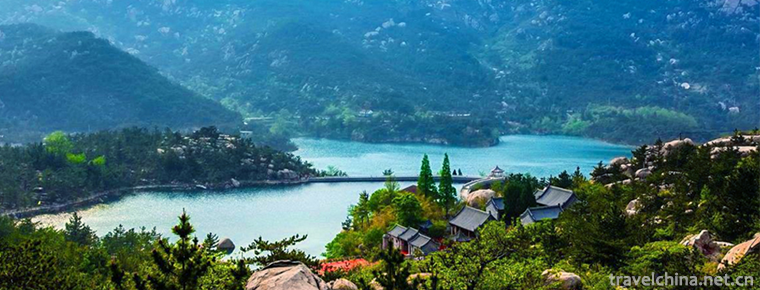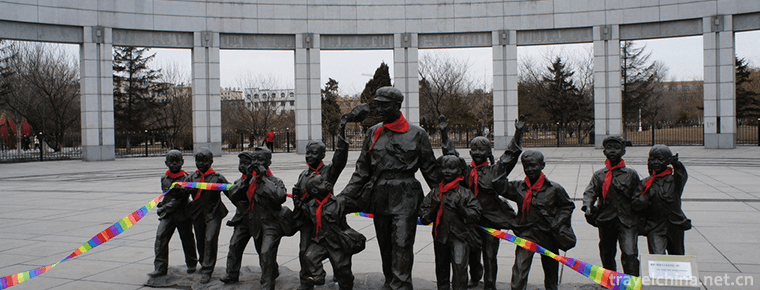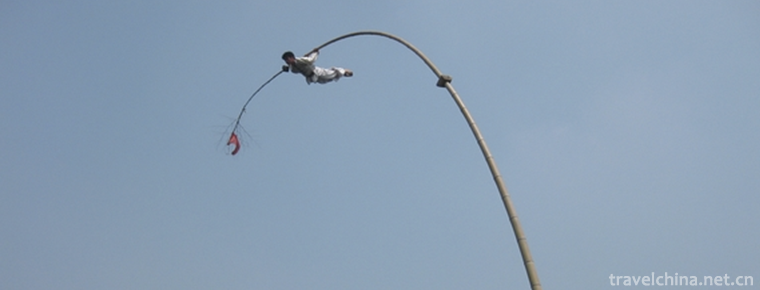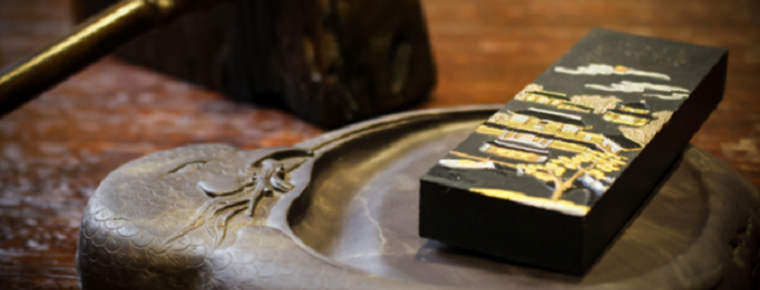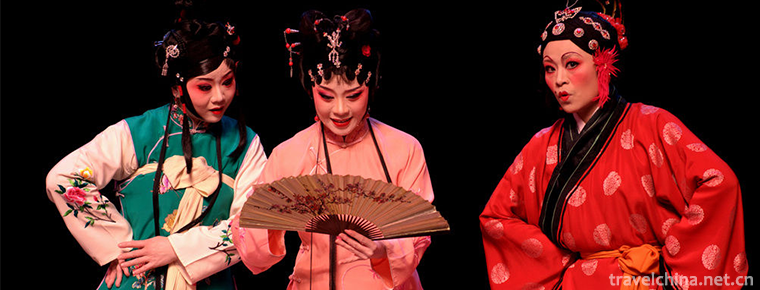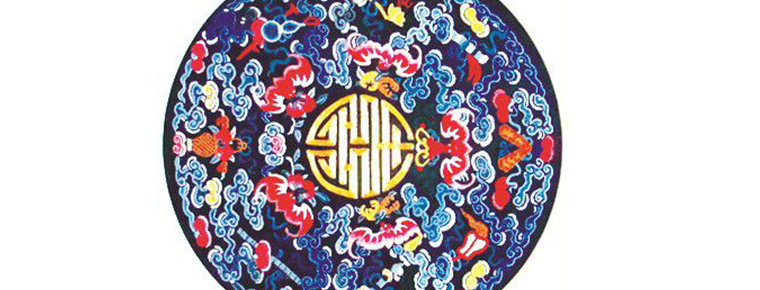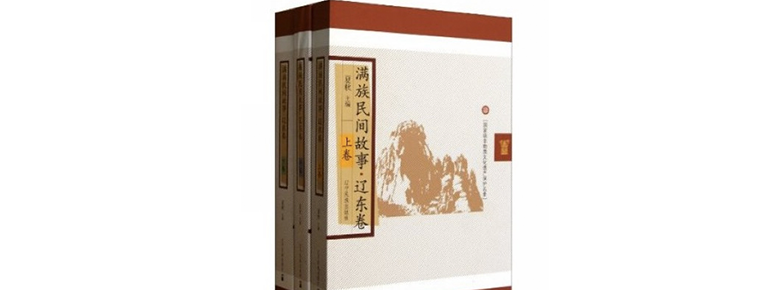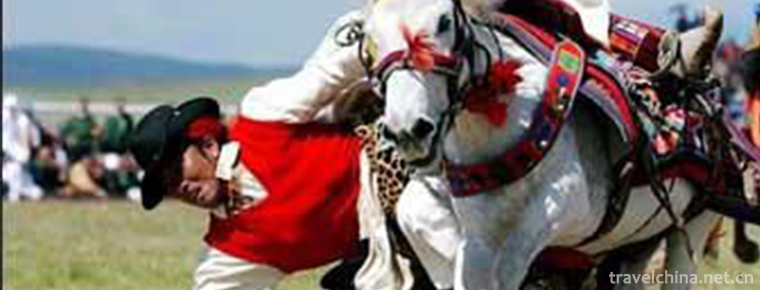Yunnan Nationalities Village
Located in the southwest suburb of Kunming City, Yunnan Province, Yunnan Ethnic Village covers 89 hectares. It is a window reflecting and displaying the social and cultural customs of 26 ethnic groups in Yunnan Province. It is a national AAAA-level tourist attraction, a national cultural base of the National People's Committee, a CIOFF China Committee folk traditional cultural base and one of the first contact points of the national ethnic work of the National People's Committee.
General situation
Yunnan Ethnic Village covers an area of 1264.96 mu, of which the water area is 463.96 mu. Set Yunnan's main Dai, Bai, Yi, Naxi, Wa, Brown, Jinuo, Lahu, Tibetan, Jingpo, Hani, De'ang, Zhuang, Miao, Shui, Nu, Mongolian, Buyi, Dulong, Lisu, Pumi, Manchu, Hui, Yao, Achang and other minority villages, ethnic dance halls, ethnic squares, Yun Nan Minority Museum, Laser Fountain, Water Curtain Film and other tourist facilities. Ethnic villages use the method of restoring display to show Yunnan's ethnic customs. Entering the village, we can only see different styles of ethnic villages distributed in the meantime, scattered in different ways, each exhibition style, the rich and colorful cottage buildings, production, life and religious customs of ethnic minorities are truthfully displayed, which is the epitome of Yunnan ethnic culture.
The main gate of Yunnan Ethnic Village is a group of magnificent steel framed buildings. At the head of the door hangs five vigorous bronzing letters of "Yunnan Ethnic Village". In the middle is a Golden Peacock logo, which symbolizes the auspicious happiness and prosperity of Yunnan Ethnic Village. In front of the gate is a broad and smooth crowd distribution square, and in the lawn below is a group of white elephant sculptures called "White Elephant Welcome Guests".
In Yunnan ethnic village scenic area, land and water are interlaced, fresh and elegant, and the scenic spots of villages are scattered in different places. There are shady paths, pavilions and corridors, arch bridges and stone steps, which are connected with the first and last of Dianchi Lake Avenue.
In the villages, visitors can not only understand the architectural style, costumes and customs of Yunnan ethnic groups, but also watch laser fountains, water curtain movies, folk songs and dances, elephant performances. Miss guides dressed in ethnic costumes provide tour guide services for tourists and explain the customs of ethnic minorities. Combining with the festivals of various ethnic minorities, there are also ethnic festivals such as "March Street" of Bai nationality, "Water Sprinkling Festival" of Dai nationality, "Torch Festival" of Yi nationality, "Dao Gan Festival" of Lisu nationality, "Mu Nao Song" of Jingpo nationality and "Three Does Festival" of Naxi nationality in the village, which are important tourist attractions of Yunnan.
Bai people's houses have always been valued by the architectural circles at home and abroad. The layout of "Three Squares, One Wall" and "Four in Five Courtyards" is tidy and practical. The courtyards of Daiwa with pink walls are not inferior to the gardens in the south of the Yangtze River and the big houses in the north, whether they are wood carvings, paintings, stone carvings or clay workers. The mysterious Solar Calendar Column Square, which connects with the sky in the Yi village, and the red palm house, show the ancient and open-minded civilization of this nation; the large house with bamboo, wood and grass roof of Jino nationality; and the creation myth of Lahu gourd make you see what is "the mysterious gourd of the universe".
As an important part of Kunming Dianchi National Tourist Resort, Yunnan Ethnic Villages are a window reflecting and displaying the social life of all ethnic groups in the frontier, and add another unforgettable tourist attraction to the beautiful Spring City.
Construction theme
Basic thinking
According to the development trend of tourism market and the specific reality of Yunnan ethnic villages, and considering the development conditions and influencing factors of Yunnan ethnic villages comprehensively, the basic ideas of the Second Entrepreneurship of Yunnan ethnic villages are as follows: based on Yunnan ethnic culture, recreational environment, natural and location conditions, focusing on three types of tourism resources: national leisure and vacation, national culture and Kunming historical culture. Ethnic sightseeing, featured catering and tourist shopping, as general development objects, complement each other and show that Yunnan Ethnic Villages, as a "national cultural paradise, leisure and vacation destination", are the main positioning features, constantly enhancing the intrinsic attraction of Yunnan Ethnic Villages, realizing the combination of sightseeing and vacation, and taking vacation as the main project cluster, so as to form a cluster that can adapt to the changing tourism market. Sustainable development of the industrial system.
Theme image
The theme images of the second entrepreneurship and development of Yunnan ethnic villages are: national cultural amusement park, leisure and holiday destination.
Basic policy
1. A prominent point - highlighting Yunnan's national culture.
2. Two improvements - increase the proportion of leisure and holiday tourists, and increase the proportion of high-end and overseas tourists.
3. Three key points: cultivating leisure and vacation characteristics, marketing and publicity, and improving management.
4. Four combinations - the combination of culture and tourism, the combination of nature and humanity, the combination of tradition and modernity, and the combination of quantity and quality.
geographical environment
Yunnan Ethnic Village is located in the national tourism resort area of Dianchi Lake in Kunming. It is located in the south of the urban area of Kunming. The ridge on the north coast of Dianchi Lake (narrow Peninsula beach from east to west) covers an area of 20,000 mu. It has a natural bathing ground and sports training base. It is separated from Xishan Forest Park, Daguan Park, Zhenghe Park and other scenic spots. There is a ropeway connecting Xishan Longmen, 10 kilometers away from the urban area.
Main villages
Bai Nationality Village
It covers 62.5 mu. The village is dominated by Bai traditional dwellings with flying eaves, Dougong and carved beams and painted pillars. The layout of "Three Squares and One Wall", "Four Seasons and Five Skylines", "Tie-dyeing Square", "Wooden Carving House", "Garden Tea House", "Platform", "Benzhu Temple" and "Three Pagodas of Chongsheng Temple" in Dali make the whole village courtyard one after another spacious and orderly. A "Dali Street" with exquisite industrial products runs through the north and south, along which there are folk halls and butterfly pavilions. Bai people are warm and hospitable, and the first guest is the Bai people's hospitality etiquette. Guests come to the house and treat each other with wine and tea. The famous three-way tea is the Bai nationality's hospitality ceremony. But the Bai people only pour half a cup of tea, pour wine needs a full cup, they think that full wine respects people, full tea deceives people. When you are warmly received by the Bai people, you should say "Move you (thank you)" to express your gratitude and gratitude. Respect for the elders is the traditional virtue of the Bai nationality. When you see the elders, you should take the initiative to say hello, greet, give way, give up your seat, bring tea and pass cigarettes. The fire pond at home is a sacred place. It is taboo to spit in the fire pond and forbid to cross it.
The main programs include folk arts such as "Overlord Whip", "Straw Hat Dance" and "Big Benqu", full of festive atmosphere; folk festival activities such as "March Street", "Around Three Spirits" and "Welcome the Bride".
Yi Village
Covering an area of more than 50 mu, the relief wall of the three tigers and the shape of the Hushan Mountain show the characteristics of the tiger culture of the Yi nationality. The totem pole in the center of the Solar Calendar Square has pictures of the sun, tiger, fire and gossip, surrounded by black and white shapes facing different 10 moons. There are 12 zodiac stone carvings around the square. The "Tuzhangfang" complex built on the hill truly reproduces the view of life of the Yi family living in harmony with nature. The buildings include Tusi Yuan, Culture Building, Intellectual Youth House, Winery and Embroidery Room. There are bullfight farms and tea mountain gardens in the village, as well as folk sports facilities such as swings. The main festivals of the Yi nationality are the Torch Festival, the Year of the Yi Nationality, the Ben worship Master's Meeting, the Mizhi Festival and the Song Dancing Festival. Torch Festival is the most common and solemn traditional festival in the Yi nationality area. It is usually held on the evening of June 24 to 26 in the lunar calendar. Every Torch Festival, the Yi people, old and young, dressed in festival costumes, played animal sacrifices and offered spiritual cards, danced and sang, raced horses and wrestled heartily. At night, holding torches, turning around houses and fields, and then gathering together to burn bonfires, dancing.
Mien Hill-tribe Village
Selecting mountainous areas to create environment is quite representative and refines the essence of Miao architecture. Diangjiaolou showcases Miao costumes and handmade crafts, while residential buildings reflect the folk style of living and living. Miao nationality is a good singer and dancer. Folk songs and Lusheng dance are very popular among the masses. Lusheng dance, also known as "dancing song", "beating dance" and "stepping on Lusheng", is a folk dance that combines self-entertainment and performance of the Miao people. Every festival, the Miao family gathered in full dress on the Lusheng court, blowing the human Lusheng, dancing and carnival. Lusheng dance is cheerful, warm and full of temperament. Young men are rough and hot, bold and steady. Girls are graceful and lyric.
Miao traditional festivals are divided into agricultural activities festivals, material exchange festivals, men and women social festivals, love and spouse selection festivals, sacrificial festivals, commemorative festivals. There is more than one festival every month. The annual "Huashan Festival" is a traditional festival of the Miao people. It is also a festival for young men and women to seek bosom friends and for middle-aged and old people to wish each other well. "Drum Festival" is the largest sacrificial activity among Miao people. At that time, a yak cattle will be killed, ancestors will be sacrificed, and relatives and friends will be invited to come together.
Dai Village
It covers an area of 27 mu, surrounded by water on three sides and covered by green trees. Dai bamboo buildings with "dry railings" connect to the solemn Myanmar Monastery through winding red sandstone paths. The towering and magnificent white pagoda, exquisite and exquisite wind and rain bridge, as well as the wind and rain pavilion, well, Bell Pavilion and other buildings are full of the rich customs of Dai family, which is the real folk landscape reproduction of Dai village.
Zhuang Village
During the annual "Water Sprinkling Festival", there are lively and cheerful "Elephant Foot Encouragement" ("Gaguang Dance") and graceful "Peacock Dance". Festivals: Dai's major festivals include Water Sprinkling Festival, Closing-door Festival and Opening-door Festival. Water-splashing Festival is the most national characteristic festival of the Dai people. It is held in June of the Dai calendar (mid-April of the Gregorian calendar) for three days. The first two days send the old and the last day welcome the new. On this day, people worship Buddha. Girls wash the Buddha's dust with fresh water drifting flowers. Then they splash water and play with each other. They wish each other well. They think that this way they will not suffer from illness. The four seasons are safe. Drums, gongs, water splashing and cheers sound like one. During this period, traditional recreational activities such as dragon boat racing, lifting, flying lights and various singing and dancing parties will also be held.
Tibetan Village
It covers an area of 21 mu. There are hilltop dwellings and carved flat-top dwellings in the village. The solemn and sacred Tibetan Buddhist temple, the spectacular white pagoda for welcoming guests, symbolizes the auspicious harmony of the "White Yak" sculpture and the unique style of Tibetan architecture complement each other. During the festival, folk songs are sung, pot village dances and string dances are danced, and horse races and archery competitions are also held by riders.
Festivals: New Year's Day in the Huangzang calendar is the most important festival for Tibetan people. They should wear costumes to worship each other and pray in monasteries. On the fifteenth day of the first lunar month, major monasteries hold magical acts, such as praying for the Great Faith; the conversion meeting on April 8th of the lunar calendar (Mu Buddha Festival, Jing Shan Gods); the Dragon Boat Festival in May; the "Wangguo" Festival in July; the divine dance meeting on the 29th of the winter month, and so on.
Yao Zhai
It is composed of dwelling cranes, bungalows, village Taoism, granary, Zhaimen and other buildings. Some Taoist cultural elements infiltrate into it, which is quite typical.
Yao music and dance, like its folk songs, originated from labor and religion. Its famous dancers, such as long drum and bronze drum, are large-scale dances offering sacrifices to Panwang and Milotta. There are also dozens of popular folk dances, such as lion dance, grass dragon dance, flower stick dance, Shangxiang dance and teacher-seeking dance.
Festivals: Big festivals include Panwang Festival, Spring Festival, Danu Festival, Zhongyuan Festival, Society Wang Festival, Qingming Festival, etc. Small festivals are almost every month. Panwang Festival, commonly known as "King of Tipping Pan" and "King of Returning Pan". It is held every three or five years on October 16 of the lunar calendar, usually by one family, several households or a village. The main ceremonies include divine prayer, King's song of the disc, long dance inspiration, and prayer for the blessing of King of the disc (Panhu). Panwang Festival, generally known as the "Mianzhi" Yao festival, is very grand.
Achang Village
Taking a compound college building as the main body, it echoes with other buildings such as Zhaimen and handicraft workshops. The green tile brick walls and stone foundation pillars are quite distinctive. The Achang people are warm and hospitable, respecting the old and loving the young. Hakka Rest, the host should drink good tea, dinner courtesy to the seats, such as young guests can be excused from sitting in the sideseat or below; when the toast pour tea, avoid rudeness to accept. There is a custom of persuading people to eat, no matter whether they drink alcohol or tea or not, they are not allowed to accept it; when they are persuaded to eat, they should reach out and fly bowls to each other, whether they are full or not; when they receive or stand up to salute, they are regarded as respectful. The main religious festivals are "Into the depression", "Out of the depression", "White firewood" and "Water Festival". Apart from religious festivals, the Achang ethnic group in Hulasa has the same festivals as the Dai ethnic group, such as rushing to swing, pedaling, street festivals, tasting new festivals and Water-Splashing festivals.
Mosuo house
Close to the Lugu Lake, there is a "wooden corrugated house" inhabited by Mosuo people, which is called "Mosuo House" because of its primitive and simple style built entirely of logs. Mosuo people live near Lugu Lake in Yongning area of Northwest Yunnan plateau, with a population of more than 80,000. Up to now, they still retain the living habits of matrilineal clans and matrilineal families. This peculiar folk custom has attracted the attention of anthropologists all over the world, and has added a strange and mysterious color to the Mosuo people from time to time.
Tour information
Bus
1. Take No. 44 and No. 73 bus (ticket price is 1 yuan) or No. A1 bus (ticket price is 2 yuan) and No. 44 bus routes at Kunming Station: (starting station), Kunming Station (railway hostel), Ming Road (Shuanglong Mall), Shuanglong Bridge (Huancheng South Road), Dianchi Crossing (Huancheng South Road), Yanjiadi (Dianchi Road), Jinniu District, City Intermediate Court and Fuhai Township (South Asia Style Garden) Zhenghe District (Rixin West Crossing), Guangfu Crossing (Green World), Yudui Village (Yinhai Mountain and Water Interval), Daba Village, Hewei Village (Dianchi Road), Saigon Wharf (Dianchi Road), Dianchi Resort Management Committee, 7 km (Dianchi Road), Hongta Crossing (Dianchi Road), Yunnan Ethnic Village (Yunnan Ethnic Museum), Haiyuan Park, (Terminal to Station)
Bus routes of Route 73: (starting station), Huguo Road (south of Dongkou of Nanping Street), Shengqiao (Jinbi Road), Jinmafang, Jingguo Crossing (Jinbi Road), Maile Temple, Workers'New Village (Xichang Road), Dianchi Crossing (Huancheng South Road), Yanjiadi (Dianchi Road), Jinniu District, City Intermediate Court, Fuhai Township (South Asian Style Garden), Zhenghe District (Nixinxi Crossing) Guangfu Crossing (Green World), Yudui Village (Yinhai Mountain and Water Interval), Daba Village, Hewei Village (Dianchi Road), Saigon Wharf (Dianchi Road), Dianchi Resort Management Committee, 7 km (Dianchi Road), Hongta Crossing (Dianchi Road), Yunnan Ethnic Village (Yunnan Ethnic Museum), Haiyuan Park, (End to End)
Bus Route A1: Expo Park, Bailong Village, Haodu Furniture Market, Shizha Overpass, Xinying Crossing, Yan'an Hospital, Dongjiawan, Shengsheng Bridge (Jinbi Road), Jinmafang, Maile Temple, Workers'New Village (Xichang Road), Dianchi Crossing (Huancheng South Road), Yanjiadi (Dianchi Road), Jinniu District, City Intermediate Court, Zhenghe District (Nixinxi Crossing) Guangfu Crossing (Green World), Yudui Village (Yinhai Mountain and Water Room), Daba Village, Hewei Village (Dianchi Road), Saigon Wharf (Dianchi Road), Dianchi Resort Management Committee, Dianchi College, Yunnan Ethnic Village (Yunnan Ethnic Museum) (final stop)
Sightseeing route
Yunnan Ethnic Villages Tourist Line 1
Daizhai-Shui, Buyizhai-Wa, Bronzhai-Miaozhai-Jino, Lahuzhai-Yao-Bai-Zhuang-Naxi-Mosuo Home-Yi Village-Jixiangyuan-Hanizhai-De'ang-Tibetan Village-Jingpo-Achangzhai
Yunnan Ethnic Villages Tourist Line 2
Dai Zhai-Dao Gan Square (Grand Canyon Four Ethnic Groups) - Miao Zhai-Yao Village-Hui Village-Manchu Courtyard-Jixiangyuan-Hani Zhai-De'ang Zhai-Tibetan Village-Jingpo Zhai-Achangzhai
Yunnan Ethnic Villages Tourist Line 3
Tibetan Village-Achangzhai-Jingpozhai-De'ang Zhai-Hani Zhai-Jixiangyuan-Yi Village-Mosuo's House-Naxi Village-Zhuang Village-Bai Village-Mongolian Village-Wa, Bronzhai-Miaozhai-Daoshan Square (Grand Canyon Four Ethnic Groups) -Hanizhai-Tibetan Village-De'ang Zhai-Jingpo-Achangzhai
Tickets for scenic spots
Tickets for Yunnan Ethnic Villages are 90 yuan per person
Ticket notice:
1. Place of ticket purchase: main entrance or entrance of South and North entrance.
2. On the basis of student certificate, a half-price discount of 45 yuan per person is offered to university (college), secondary school, primary and secondary school students (excluding adult education and correspondence education).
3. Children under 1.2 meters in height (free) should be accompanied by their parents. The annual card should be used with a certificate. The relevant certificate is valid only for their own use and can not be lent.
4. Ticket-free objects: elderly people over 65 years of age with identity cards; holders of retirement cards; holders of disability cards; holders of press cards of the State Press and Publication Administration or of the State Administration of Radio and Television; holders of soldier's cards and military officer's cards; children who are less than 1.2 meters in height.
5. The scenic spot is a ticket system. Each ticket is limited to one person. It is not reissued if lost. The ticket is valid on the same day. It will be invalidated after the Deputy vouchers are torn off. If visitors enter the park again on the same day, they need to re-purchase the ticket.
6. We change the time of village performance from time to time, suspend the opening of scenic spots, control the number of scenic spots entering the park or cancel village performances without prior notice for the following reasons: scenic area accommodation, bad weather, maintenance and security, public order or other activities of force majeure. Please pay attention to the on-site announcement, please understand.
7. Any statutory announcement prohibits the carriage of dangerous goods, drugs, drugs and pets into scenic spots. Distribution of printed materials, peddling of any goods or services, parades or speeches, and other unauthorized public gatherings are strictly prohibited in the scenic area.
8. We have the right to refuse handbags, parcels or other items to be brought into the scenic area, and to handle all unmanned items as we deem appropriate.
9. Please respect other tourists and performers in the scenic area. Do not use indecent language or do any dangerous, illegal or other unreasonable acts.
10. Smoking is permitted only in specific smoking areas. Please refer to tour guides or consult service personnel in scenic spots.
11. In case of any change in fare policy, the announcement in the ticketing hall shall prevail.
Scenic spot honor
Golden Week Tourist Reception Information Publishing Unit Designated by National Tourism Administration
National AAAA Tourist Scenic Spot
National Tourism Standardization Demonstration Unit
National Cultural Industry Demonstration Base
"National Cultural Base" of the Cultural Propaganda Department of the National People's Committee
CIOFF International Folk Art Festival Organizes Chinese Committee "Folk Traditional Culture and Art Base"
Yunnan Civilized Scenic Spot
Yunnan Ethnic Culture Base
Protection of intangible cultural heritage in Yunnan Province.
























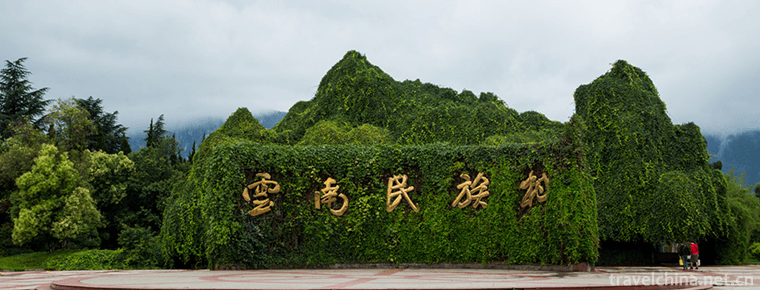
-
Chengde Summer Resort and its surrounding Temple scenic spot
Chengde Summer Resort and its surrounding Temple scenic spot, World Cultural Heritage, established in 1994. It is located in Chengde City, Hebei Province.
Views: 196 Time 2018-11-24 -
two dragons mountain Erlongshan
Erlongshan is the first national AAAA class tourist area, known as "Harbin East Garden", located 50 km east of Harbin, 127 degrees east longitude 27 minutes 41 seconds, 45 degrees north lati.
Views: 173 Time 2018-12-22 -
Leifeng Memorial Hall in Fushun
The Leifeng Memorial Hall in Fushun City is located at No. 61, East Section of Peace Road, Wanghua District, Fushun City, Liaoning Province. It covers an area of 99900 square meters, near the army sta.
Views: 168 Time 2019-01-12 -
Wu Songgun Taiwan Wetland Forest Park
Wu Song Gu Taiwan Wetland Forest Park: Wu Song Gu Taiwan Wetland Forest Park with a total area of 53.46 hectares is located in the eastern part of Baoshan District.
Views: 189 Time 2019-02-22 -
High bar technology
High-pole boat acrobatics is a traditional folk acrobatics project which simulates silkworm babies'silk spinning as cocoon action performed at the sacrificial ceremony of Silkworm God in Zhejiang Prov.
Views: 139 Time 2019-04-30 -
The Making Skills of Hui Ink
Hui ink production technology, Jixi County, Shexian County, Huangshan Tunxi District, Anhui Province, local traditional handicraft, one of the national intangible cultural heritage..
Views: 80 Time 2019-05-04 -
Liyuan Opera
Liyuan Opera is one of the traditional operas in Fujian Province. Liyuan Opera originated in Quanzhou in the Song and Yuan Dynasties. It is also called "the voice of Fujian and Zhejiang" and.
Views: 156 Time 2019-05-12 -
Manchu embroidery
Manchu embroidery, commonly known as "needle embroidery", "tie flowers" and "embroidery", was originally popular in the vast rural areas where Manchu people lived togethe.
Views: 264 Time 2019-05-16 -
Manchu Folk Stories
Liaoning is a region where Manchu people have formed, risen and grown up. It contains extensive and profound Manchu cultural relics and connotations. Manchu folktales originated from the Manchu people.
Views: 110 Time 2019-05-18 -
Jockey Club
The horse race held every June in the Tibetan calendar is a grand traditional festival in the northern Tibetan grassland, also known as the "Grassland Festival", which lasts from 5 to 15 day.
Views: 179 Time 2019-06-12 -
Danba pig leg
Xiang Pigs are mainly green fodder. They never feed artificial feed. They graze with cattle and sheep all year round. They have long mouth and small ears, narrow head, straight forehead, narrow body and protruding back, strong limbs and fast running..
Views: 234 Time 2020-12-06
